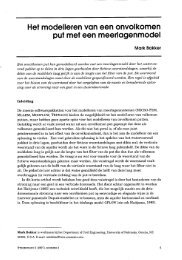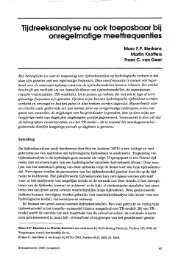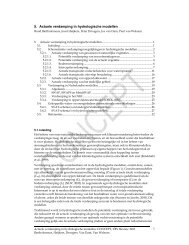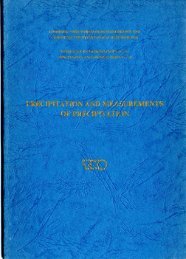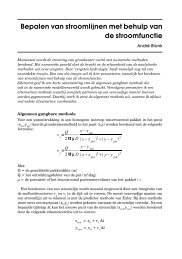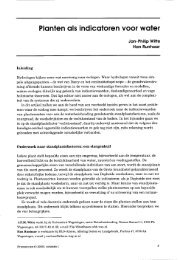Hydro-ecological relations in the Delta Waters
Hydro-ecological relations in the Delta Waters
Hydro-ecological relations in the Delta Waters
Create successful ePaper yourself
Turn your PDF publications into a flip-book with our unique Google optimized e-Paper software.
As birds are ma<strong>in</strong>ly top predators, <strong>the</strong>y accumulate quite a lot of toxic<br />
substances. The dramatic effects of chlor<strong>in</strong>ated hydrocarbons,<br />
<strong>in</strong>secticides and chlor<strong>in</strong>ated biphenyls on many piscivores <strong>in</strong> general<br />
and especially on <strong>the</strong> Sandwich Terns <strong>in</strong> <strong>the</strong> sixties, decimat<strong>in</strong>g <strong>the</strong>ir<br />
pop~lations are well known (Koeman and Van Eenderen, 19721. The effects<br />
of accwwlation of pollutants ere, hmever, not always so obvious,<br />
never<strong>the</strong>lens <strong>the</strong>y wy severely affect populations. Pew data on<br />
conoentrations of pollutanrs <strong>in</strong> birds <strong>in</strong> <strong>the</strong> <strong>Delta</strong> area are avaFLahlc.<br />
However, experiments with Tufted Ducks clearly deman$trafed that when<br />
fed With Zebra Mussels from <strong>the</strong> Rar<strong>in</strong>gvliet <strong>the</strong>ir reproductive oatput<br />
was v eq much depressed IMarquenie, et al. 1986; Seholten and Poekema,<br />
1988). Clearly pollution is a major factor affect<strong>in</strong>g birds <strong>in</strong> <strong>the</strong> <strong>Delta</strong><br />
area and, as its effects are vey diverse and by now not very well<br />
onderstood, much mere attention should he paid to this problem <strong>in</strong> <strong>the</strong><br />
Eutnre.<br />
Babitat loss is ~f course a very impartant factor <strong>in</strong>fluenc<strong>in</strong>g birds.<br />
The effects are obvious. In <strong>the</strong> rema<strong>in</strong><strong>in</strong>g areas bird densities<br />
<strong>in</strong>crease, caus<strong>in</strong>g a higher predation pressure and hence a smaller food<br />
supply. This tpge<strong>the</strong>r with an <strong>in</strong>ereased level of social iateractions<br />
between <strong>in</strong>dividuals can reduce quite aubsfantiallp <strong>the</strong> food <strong>in</strong>take<br />
lead* td death. detailed revietv af <strong>the</strong> effecrs of habitat loss bn<br />
wader populatione is given by Goss-Custacd, 1985. It shauld be nated<br />
that hahicat lams is not only cased by physical removal of an anea but<br />
also by deterioration of <strong>the</strong> food supplp e.g. due to chang<strong>in</strong>g<br />
environmental condition#. In <strong>the</strong> Westerschelde <strong>the</strong> <strong>in</strong>creased dredg<strong>in</strong>g<br />
activities cause <strong>the</strong> <strong>in</strong>tertidal flats to become more sandy shee <strong>in</strong> <strong>the</strong><br />
larger channels higher current speeds occor, <strong>in</strong>fluenc<strong>in</strong>g <strong>the</strong><br />
sedimentation patterns. The benthic fauna and <strong>the</strong> numbers of waders are<br />
much smaller on send- than on mudflats. This is especially <strong>in</strong> <strong>the</strong><br />
Wesrerschelde a severe threat.





